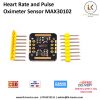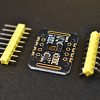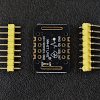Sensors
MAX30102 Heart Rate and Pulse Oximeter Sensor
Availability:
Out of stock
LKSEN00010
MAX30102 Heart Rate and Pulse Oximeter Sensor module uses a red LED (660nm), infrared LED (880nm), and photodetector to approximate blood oxygen content and heart rate pulses. The sensor can be placed on a finger, wrist, or other area with significant blood flow to measure these parameters.
Rs 400.00 Rs 1,200.00
Out of stock
CompareMAX30102 Heart Rate and Pulse Oximeter Sensor
The MAX30102 is an integrated pulse oximetry and heart-rate monitor module. It includes internal LEDs, photodetectors, optical elements, and low-noise electronics with ambient light rejection. Here are the detailed specifications and features of the MAX30102 module:
Specifications
- Power Supply Voltage: Operating Voltage: 1.8V and 3.3V for LEDs
- Current Consumption: Idle mode: 0.7µA / Active mode: Varies with configuration, typically around 600µA to 1.8mA for heart rate measurement
- Measurement Range:
- Heart rate: 30 to 240 beats per minute (bpm)
- SpO2 (blood oxygen level): 0% to 100%
- LED Wavelengths:
- Red LED: 660 nm
- Infrared LED: 880 nm
- Communication Interface:
- I2C (Inter-Integrated Circuit) protocol
- I2C Address: 0x57 (7-bit)
- Dimensions: Small form factor, typically around 14mm x 14mm
Pin Configuration
- VIN: Power supply input (1.8V to 5.5V)
- GND: Ground
- SCL: I2C clock
- SDA: I2C data
- INT: Interrupt output (optional)
- RD: Red LED power (optional, can be left unconnected if not used)
- IR: Infrared LED power (optional, can be left unconnected if not used)
Features
- Heart Rate Monitoring: Measures heart rate using photoplethysmography (PPG) by detecting blood volume changes in the microvascular bed of tissue.
- Pulse Oximetry: Measures SpO2 (blood oxygen saturation) by using red and infrared LEDs to measure the amount of oxygenated and deoxygenated hemoglobin.
- Low Power Consumption: Optimized for battery-powered applications with ultra-low power consumption.
- High Sensitivity: High-sensitivity photodetectors ensure accurate measurements even with low perfusion.
- Ambient Light Rejection: Built-in ambient light cancellation for accurate readings under various lighting conditions.
- I2C Communication: Simple communication with microcontrollers via the I2C protocol.
A module datasheet can be found here.
Based on 0 reviews
Be the first to review “MAX30102 Heart Rate and Pulse Oximeter Sensor”
You must be logged in to post a review.












There are no reviews yet.